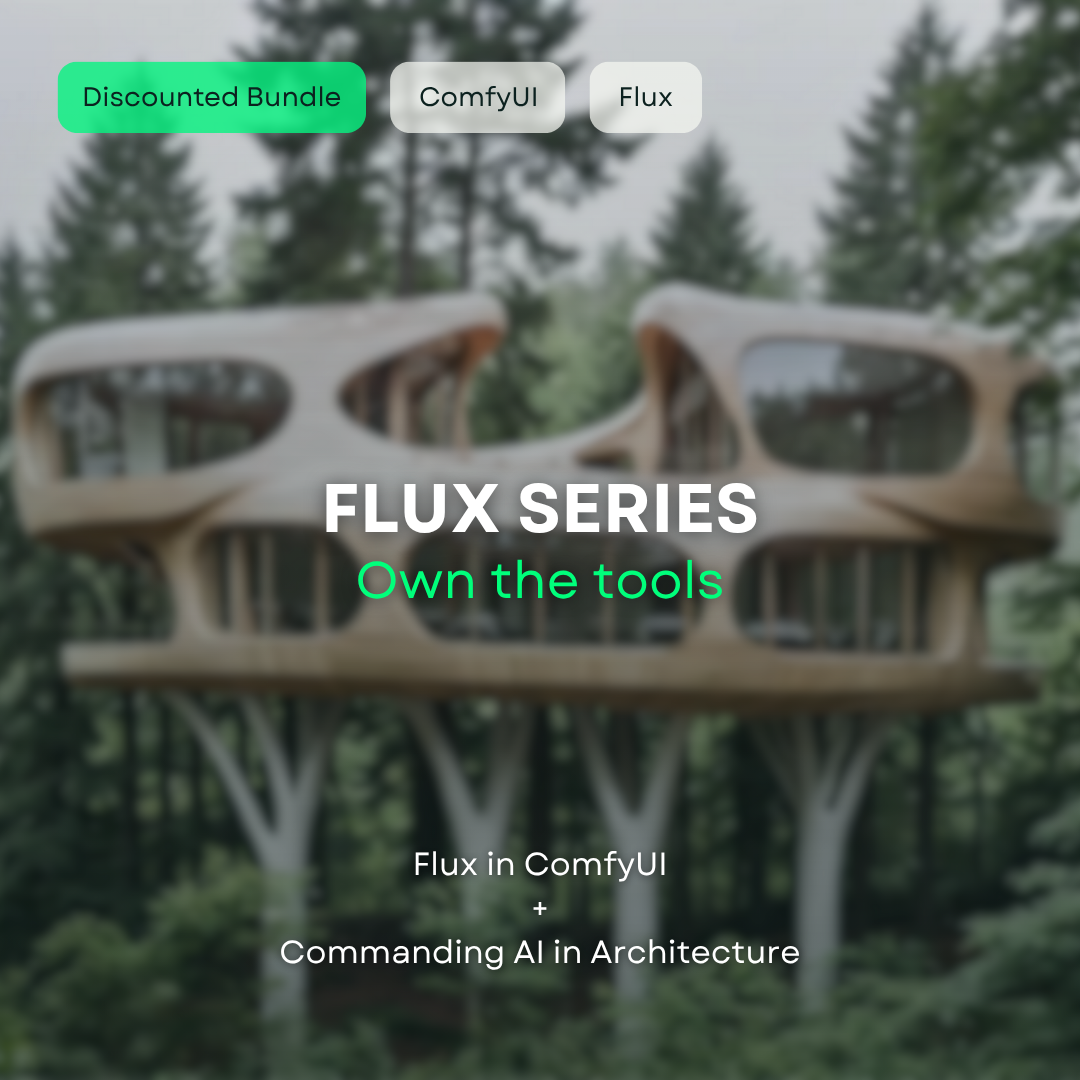
FLUX Series
Own the tools
The FLUX Series is designed for practitioners who want full agency over their AI tooling—from model selection and training to integration within real design workflows.
In Flux in ComfyUI, participants explore FLUX as a family of advanced text-to-image models built for high fidelity, prompt adherence, and stylistic control. Working inside ComfyUI, they study the theoretical background of Stable Diffusion, then move into hands-on use of ControlNet and custom LoRAs to steer structure and style. The workshop covers dataset curation, parameter choices, and strategies for building bespoke ComfyUI graphs that encode architectural intentions rather than ad-hoc experiments.
Commanding AI in Architecture extends this technical layer into an end-to-end design methodology. Participants examine how Midjourney, SD, FLUX, Forge, and Photoshop AI can be combined across stages—from early brainstorming and reference generation to segmentation-driven workflows and Flux-based denoising pipelines. The course emphasizes control: using 3D models, ADE20K segmentation, and ControlNet-enabled flows to “freeze” geometry, inject site-specific constraints, and refine outputs without losing the architect’s voice.
The bundle is ideal for architects already experimenting with diffusion models who now want to formalize their practice into robust, repeatable workflows that can sit comfortably inside office production.
What you will learn:
Across the two workshops, participants will learn to:
- Grasp the theoretical basis of Stable Diffusion and its relationship to FLUX models in architectural contexts.
- Configure and deploy FLUX checkpoints within ComfyUI, including ControlNet and LoRA components tailored for architecture.
- Train and apply custom LoRAs to encode office-specific styles, project typologies, or material languages.
- Design ComfyUI workflows that integrate multiple guidance signals—geometry, segmentation, prompts—to achieve controlled, iterative outputs.
- Use Forge, ComfyUI, and Photoshop in tandem to move from 3D models and sketches to production-quality images.
- Apply segmentation-based methodologies (e.g., ADE20K) to define and manipulate architectural categories directly within images.
- Implement Flux-driven denoising strategies for refining scenes while preserving structure and intent.
- Evaluate and iterate on AI outputs using empirical case studies and project-based exercises, building confidence in AI-augmented design decision-making.
Mentors

Ismail Seleit
Ismail Seleit is a design architect at the industry-leading Foster and Partners, specialising in design technology. With extensive experience in architecture and computational design, Ismail has contributed to diverse projects, ranging from design competitions to the realisation of buildings on various scales. Actively supporting design teams, Ismail leverages his expertise in BIM and Computational Design to navigate complex challenges.
His primary focus is on enabling project teams to achieve efficient, informed, and collaborative design outcomes. Collaborating across departments, Ismail works to implement innovative methodologies to manage the design process from urban planning to product scale.
Simultaneously, Ismail engages in applied research, exploring new opportunities for implementing cutting-edge design workflows. His research specifically delves into the integration of generative AI image-generating tools, with a keen interest in the combination of Stable Diffusion and ControlNet.
This unique approach offers various techniques for generating controlled image compositions based on diverse user-defined inputs. Beyond his architectural pursuits, Ismail is an ambient-electronic music producer, with a focus on film scores.
He has composed and produced soundtracks for architectural short films at Foster and Partners and contributed to the music and sound design of various independent films. Ismail’s passion for creative thinking, coupled with his dedication to design problem-solving, continues to drive his multifaceted and innovative endeavours.

Fredy Fortich
Architect / Engineer focused on computational design; particularly BIM coordination in Revit, performance-based design, generative design and machine learning methods
Master of Science -Building Technology -TU Delft, Netherlands
Master of Architecture -Universidad de los Andes, Bogotá, Colombia
Technical Architect at MVRDV
BIM Manager at French Studio
AI Researcher on Diffusion Models
Programme
Important Info:
- It is advisable to have active plans for the following tools: Midjourney, Prome AI, Krea AI and Runway. This tools covered have free versions, except for Midjourney.
- Basic knowledge of interior design and architecture is recommended.
